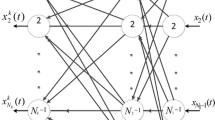Abstract
A nonlinear black-box modeling approach using a state–space recurrent multilayer perceptron (RMLP) is considered in this paper. The unscented Kalman filter (UKF), which was proposed recently and is appropriate for state–space representation, is employed to train the RMLP. The UKF offers a derivative-free computation and an easy implementation, compared to the extended Kalman filter (EKF) widely used for training neural networks. In addition, the UKF has a fast convergence rate and an excellent capability of parameter estimation which are appropriate for online learning. Through modeling experiments of nonlinear systems, the effectiveness of the RMLP trained with the UKF is demonstrated.
Similar content being viewed by others
Reference
K.S. Narendra K. Parthasarathy (1990) ArticleTitleIdentification and control of dynamical systems using neural networks IEEE Transactions on Neural Networks 1 4–27 Occurrence Handle10.1109/72.80202
Rivals I., Personnaz L., (1996), Black-box modeling with state–space neural networks. In: Zbikowski R., Hunt K.J. (eds). Neural Adaptive Control Technology. pp. 237–264, World Scientific.
S. Haykin (1999) Neural networks: a Comprehensive Foundation EditionNumber2 Prentice Hall: Upper Saddle River NJ
A.F. Atiya A.G. Parlos (2000) ArticleTitleNew results on recurrent network training: unifying the algorithms and accelerating convergence IEEE Transactions on Neural Networks 11 697–709 Occurrence Handle10.1109/72.846741
Hammer B., Steil J.J., (2002), Tutorial: Perspective on learning with RNNs, In: Proceedings of the European Symposium on Artificial Neural Networks (ESANN). pp. 357–369.
G.V. Puskorius L.A. Feldkamp (1994) ArticleTitleNeurocontrol of nonlinear dynamical systems with Kalman filter trained recurrent networks IEEE Transactions on Neural Networks 5 279–297 Occurrence Handle10.1109/72.279191
A. Sitz U. Schwarz J. Kurths H.U. Voss (2002) ArticleTitleEstimation of parameters and unobserved components for nonlinear systems from noisy time series Physical Review E 66 016210 Occurrence Handle10.1103/PhysRevE.66.016210
Julier S.J., Uhlmann J.K., (1997), A new extension of the Kalman filter to nonlinear systems. In Proceedings of AeroSence: The 11th International Symposium on Aerospace/Defence Sensing, Simulation and Controls.
S. Julier J. Uhlmann H.F. Durrant-Whyte (2000) ArticleTitleA new method for the nonlinear transformation of means and covariances in filters and estimators IEEE Transactions on Automatic Control 45 477–482 Occurrence Handle10.1109/9.847726
Wan E.A., van der Merwe R., (2000), The unscented Kalman filter for nonlinear estimation, in Proceedings of the IEEE 2000 Adaptive Systems for Signal Processing, Communications and Control Symposium (AS-SPCC), pp. 153–158.
Wan E.A., van der Merwe R., (2001), The unscented Kalman filter. In: Haykin S. (eds). Kalman Filtering and Neural Networks, pp. 221–280, John Wiley and Sons.
Choi J., Lima A., Haykin S., (May 2003), Unscented Kalman filter-trained recurrent neural equalizer for time-varying channels. In Proceedings of IEEE International Conference on Communications, pp. 3241–3245, Anchorage, USA.
Choi J., Bouchard M., Yeap T.H., Kwon O., (2004), A derivative-free Kalman filter for parameter estimation of recurrent neural networks and its applications to nonlinear channel equalization. In Proceedings of the 4th International ICSC Symposium on Engineering of Intelligent Systems. Funchal Island, Portugal, February.
J. Sjoberg Q. Zhang L. Ljung A. Benveniste B. Delyon P.-Y. Glorennec H. Hjalmarsson A. Juditsky (1995) ArticleTitleNonlinear black-box modeling in system identification: A unified overview Automatica 31 1691–1724 Occurrence Handle10.1016/0005-1098(95)00120-8
G.E.P. Box G.M. Jenkins (1976) Time Series Analysis: Forecasting and Control Holden Day San Francisco, CA
P.S. Sastry G. Santharam K.P. Unnikrishnan (1994) ArticleTitleMemory neuron networks for identification and control of dynamical systems IEEE Transactions on Neural Networks 5 306–319 Occurrence Handle10.1109/72.279193
C. Cowan S. Semnani (1998) ArticleTitleTime-variant equalization using a novel nonlinear adaptive structure International Journal of Adaptive Control and Signal Processing 12 195–206 Occurrence Handle10.1002/(SICI)1099-1115(199803)12:2<195::AID-ACS487>3.0.CO;2-K
S. Ong C. You S. Choi D. Hong (1997) ArticleTitleA decision feedback recurrent neural equalizer as an infinite impulse response filter IEEE Transactions on Signal Processing 45 2851–2858 Occurrence Handle10.1109/78.650112
Author information
Authors and Affiliations
Corresponding author
Rights and permissions
About this article
Cite this article
Choi, J., Yeap, T.H. & bouchard, M. Online State–Space Modeling Using Recurrent Multilayer Perceptrons with Unscented Kalman Filter. Neural Process Lett 22, 69–84 (2005). https://doi.org/10.1007/s11063-005-2157-2
Issue Date:
DOI: https://doi.org/10.1007/s11063-005-2157-2




